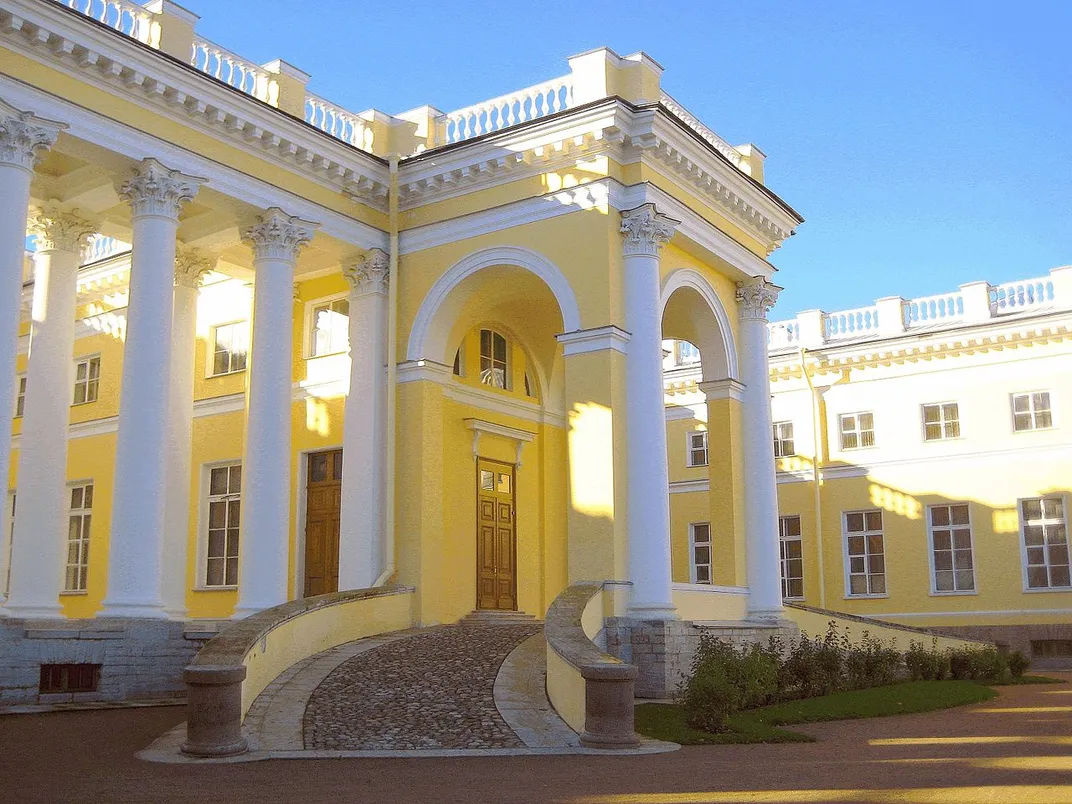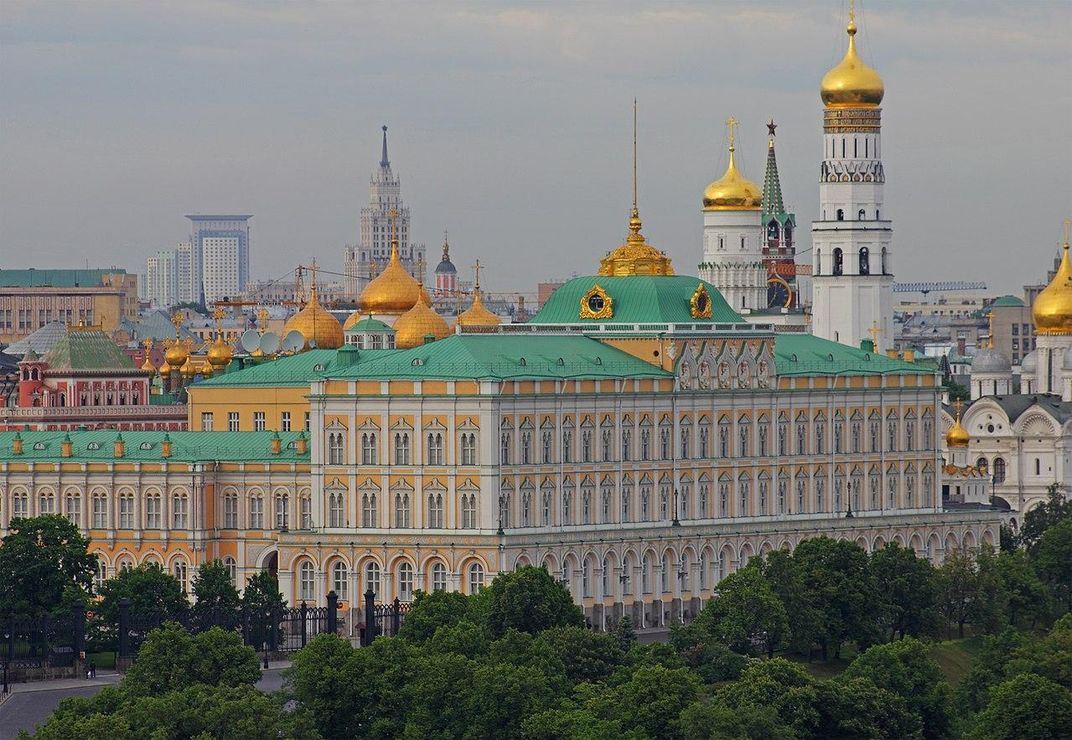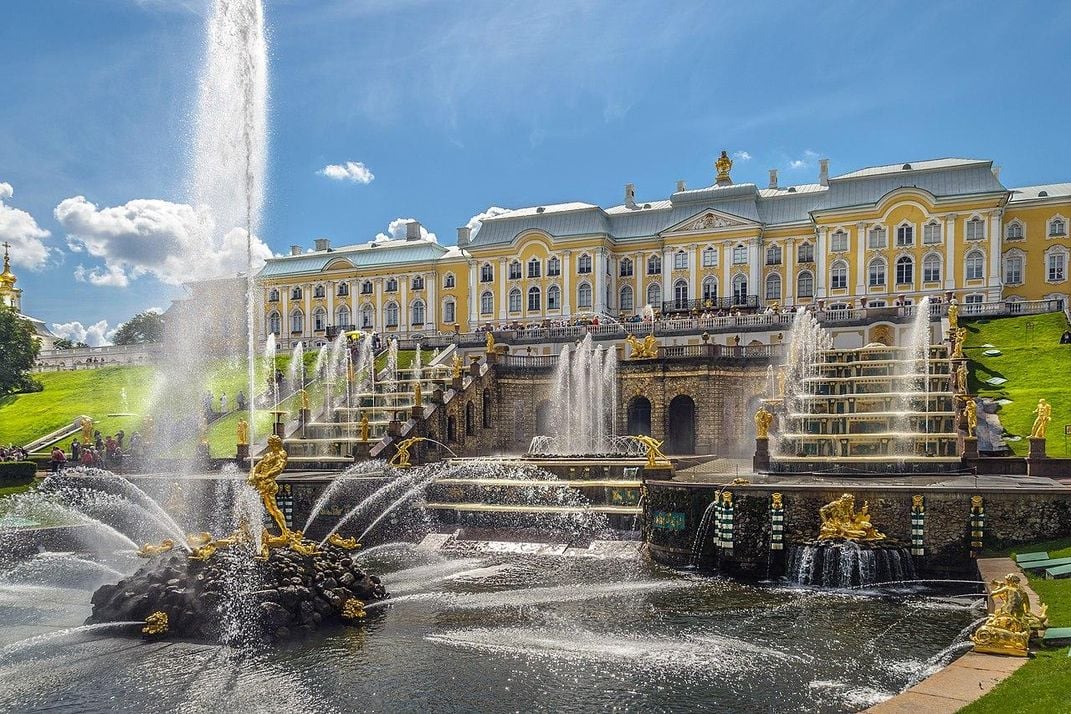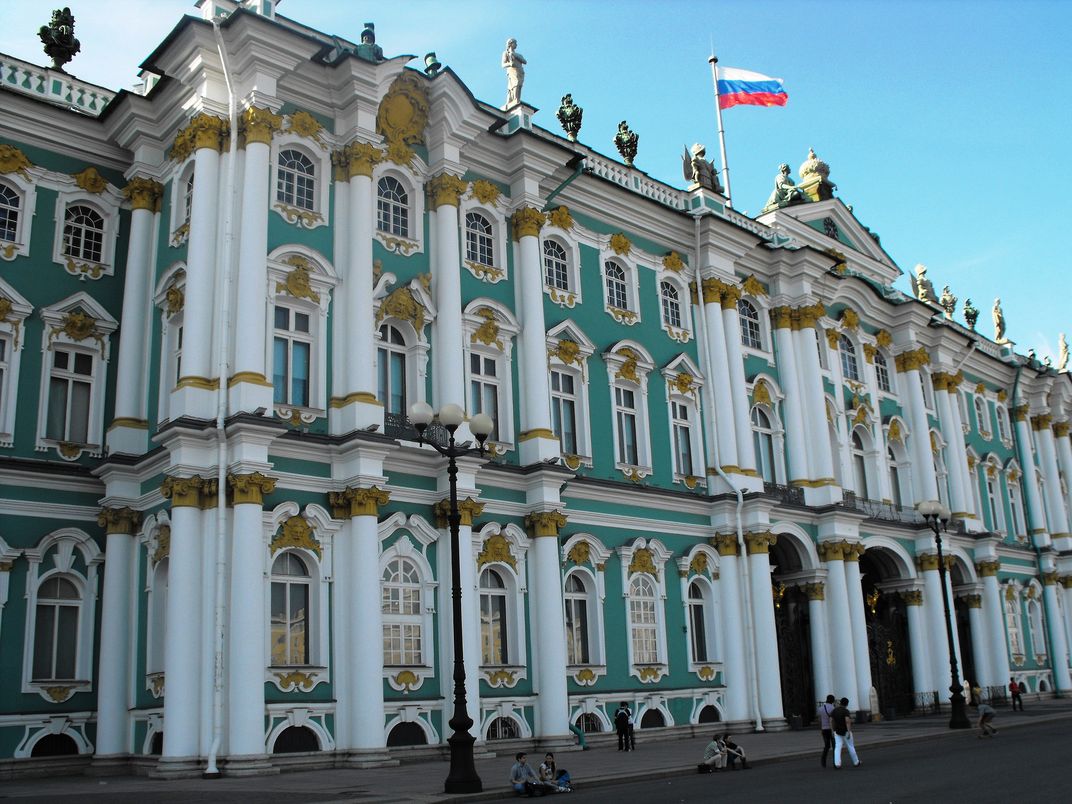From Nazi Prisons to Cat Sanctuaries, Explore the Many Lives of These Russian Palaces
Follow the footsteps of doomed royals and revolutionaries through these architectural marvels
/https://tf-cmsv2-smithsonianmag-media.s3.amazonaws.com/filer/1c/97/1c974c91-97a4-44a3-86ef-b6e6a2aa3e23/1280px-grand_cascade_in_peterhof_01.jpg)
In August 1917, former czar Nicholas Romanov, his wife and five children marched out of their palace in the Tsarskoye Selo (now Pushkin) countryside for the last time. For their last five months there, the extravagant estate served as the literal gilded cage for the ex-royal family on house arrest. The family maintained daily life—studying, doing handiwork, gardening, literally anything they could do to keep their minds occupied. On July 17, 1918, nearly a year after departing the grounds, the family and their four remaining servants were woken from their beds by their Bolshevik captors, ordered to dress, then were shot and bayoneted in the cellar of the Yekaterinburg home where they were being held.
In 1547, Ivan IV—more commonly known as Ivan the Terrible, grandson of Ivan the Great—became the first czar of Russia. He was a paranoid and ruthless leader, organizing Russia into the largest country on the planet but also executing thousands of people, including his own son and rightful heir to the crown. Ivan died from a stroke in 1584, leaving the throne to Feodor, his middle son, who ruled until his death in 1598. From there, Russia entered the Time of Troubles, a period rife with war, famine and civil uprisings. This lasted until 1613, when Michael Romanov was elected czar. He was the first cousin once removed from Feodor, and the Romanov family continued to rule Russia for about 300 years. The Romanovs lived mostly around St. Petersburg throughout their reign, which lasted until March 1917, when Nicholas II abdicated the throne. (The fall of the Romanov dynasty has been the focus of this summer's "The Last Czars" on Netflix.) The family constructed opulent palaces as their homes and getaways, which were often expanded or updated by incoming rulers.
The Romanovs left behind a legacy of palaces and residences throughout Russia that in the following years continued to live storied and unusual lives. Take your own self-guided tour to these famous former czar residences that you can still visit in Russia today.
Alexander Palace, Pushkin

Alexander Palace was built in 1796, commissioned by Catherine the Great, who wanted to give the palace to her grandson Alexander Pavlovich (who would become Czar Alexander I) when he married. Alexander, though, didn’t enjoy spending time in the palace and gave it to his brother, the future Czar Nicholas I, who extensively renovated and improved both the buildings and the grounds. The neoclassical palace has an impressive facade of columns and statuary, and inside, has a large number of religious icons and several unique art nouveau rooms.
Under Nicholas I, the palace became the summer residence for future czars, until Nicholas II, the final czar, and his family moved there full-time in 1905. Following the Bloody Sunday massacre that year in St. Petersburg, where authorities fired upon a group of peaceful demonstrators and killed more than 100 people, Alexander Palace was determined to be a safer place for the family. But when Nicholas II abdicated the throne in 1917, Alexander Palace became the family’s prison. They were executed within a year.
After the revolution, the palace had a number of uses. First it was a state museum, then temporary housing for the Soviet Union’s interior ministry and an orphanage. After the Nazis invaded, German army staff and Gestapo members stayed in the palace. They opened a prison in the basement and used the front square as an SS cemetery. In 1946, it became a Pushkin museum and home to the Institute of Russian Literature’s collections. The Russian Navy took ownership of the palace in 1951, establishing a military institute, but retaining the museum portions. In 2009, the palace once more became a state-owned museum and has remained so since.
The palace itself is currently closed for renovations, but the grounds are still open for exploration. Visitors to the site will find the New Garden, constructed in the 1740s as an extension of the nearby Catherine Palace. The garden at Alexander Park has a Chinese influence; it’s accessed by a bridge with lanterns and statues of historical Chinese figures, and has a summerhouse with five columns and a pagoda roof, five smaller colorful bridges, an abandoned theater that had Asian-inspired upturned roofing, and a small village with a pagoda-shaped observatory and typical Chinese houses. There’s also a landscape park on the grounds of a former zoo, with museums sprinkled throughout the remaining buildings.
Catherine Palace, Pushkin

What started as a simple two-story building in 1717 eventually became the opulent structure that Catherine Palace is today, stretching into a square more than a half-mile around. The original building was built for Catherine I, the second wife of Peter the Great. Their daughter, Empress Elizabeth, remodeled the building to its current glory—outfitting it with elaborate blue and white exteriors and gilding on nearly every surface inside. The largest room, the Great Hall, is one of the most heavily gilded rooms in the world. According to a local Russian tour guide for Viking Cruises, Elizabeth often used this room for gender-swap parties where men would dress as women and vice versa, because she liked the way her legs looked in men’s stockings.
The Nazis used the palace as barracks during World War II, and then deliberately destroyed it after the Germans began to retreat, leaving it to crumble and rot as a shell of what it once was. After the war, extensive restorations began, and are still ongoing.
Today, the most well known part of Catherine Palace is the mysterious Amber Room. The walls were panels of intricately designed amber and gemstones, gifted to Peter the Great in 1716. Czarina Elizabeth had the panels installed at Catherine Palace in 1755. During World War II, though, Nazis looted the palace and stole the panels. It was rebuilt in a German castle museum, then taken down two years later before the castle museum was destroyed by bombs. From there, no one knows what happened to the panels of the original Amber Room. A replica exists in Catherine Palace today, built over 25 years starting in 1979.
Kremlin, Moscow

Moscow was a seat of power in the region long before Russian rule. Evidence of human activity at the Kremlin site dates back to 500 BC. But the first known structure appeared around 1147, a wooden fort built by Yuri Dolgoruky, the Grand Duke of Kiev. This year is also generally known as the founding date of the city. In the early 14th century, after Moscow had been razed and rebuilt several times thanks to fire and invasions, stone buildings began appearing at the Kremlin site. Eventually the site was enclosed by a stone wall. When Ivan the Great appeared in the 1460s, he commissioned cathedrals and palaces be built on the spot, giving the Kremlin much of its modern look. The Russian czars continued to live here until Peter the Great moved the capital to St. Petersburg, where they lived until Moscow was restored as the capital after the revolution.
During the Bolshevik Revolution in 1917, Lenin’s followers captured the Kremlin and it became a base for the fledgling government. It was declared state property in 1918 and remained the living and working space for government officials throughout the Soviet era. In 1955, the grounds were opened to visitors.
While none of the three former czar palaces at the Kremlin (the Terem, Faceted and Great Kremlin palaces) are open for tours, visitors can still walk the grounds of the Kremlin and visit a number of other attractions—including multiple cathedrals and the armory, which holds the jeweled treasures and weapons of Russia’s royal past. The Cathedral of the Archangel Michael is particularly important to the Kremlin’s history; it contains the burial tombs of 57 past royals. A Russian tour guide at the Kremlin says Cathedral Square is nicknamed the “Circle of Life,” because the czars were baptized in one church, coronated in the one next door and buried in a third.
Peterhof Palace, Petrodvorets

Peterhof didn’t start off as the massive palace it is today; it began as a simple country estate, built by Peter the Great in 1709. But after visiting Versailles in 1717, he decided to expand the estate into something brilliant, rivaling the best the French court had to offer. He built a grand palace, gardens and fountains, causing Peterhof to quickly become the most-loved summer czar residence and a center of social life in royal Russia.
After 300 years of existence, like Catherine Palace, the Nazis deliberately destroyed Peterhof when German armies began their retreat from Russia in World War II. Unconfirmed but oft-repeated local legend, though, says that Stalin had Peterhof bombed again in December 1941, after hearing that Hitler wanted to host a Christmas party there. Restoration began after the war and still continues.
Today, visitors can explore the roughly 1,000-foot-long, bright yellow Grand Palace, but the real centerpiece is the Grand Cascade fountain around the back, built after Peter’s death when his daughter Elizabeth assumed the throne. The water feature has three waterfalls, 37 gold statues and 67 individual fountains. In the surrounding park, Peter the Great installed trick fountains triggered by stepping on a certain rock that would soak the unexpecting guests.
Winter Palace, St. Petersburg

Starting with Catherine the Great, nearly every czar used the Winter Palace as their main residence. It took eight years, employing more than 4,000 workers, to construct the luxurious interiors of more than 460 rooms. The current building is the fourth iteration of the Winter Palace. The first version was a wooden house that Peter the Great and his family used, built in 1708. In 1711, the wooden house was replaced with a stone one. In 1735, a new Winter Palace—larger and more opulent—opened at the behest of Empress Anna. This palace remained in use for 17 years, when Empress Elizabeth then decided to update and expand the Winter Palace once again, which brought it mostly to its current state. Alexander II was the last czar to live there mostly full time, and his assassination in 1881 showed that the building was a bit too large to properly protect, so future czars chose to live in the suburbs.
Since the 1917 revolution, the Winter Palace has been a museum. Today it holds part of the Hermitage, an exceptional art museum with a collection that includes works by Rembrandt and Leonardo da Vinci, a collection of Greek statuary, an authentic Egyptian mummy, the country’s most famous mechanical clock and about 3 million other treasures. The Hermitage is also famous for a legion of cats living in the cellars—about 75 former strays that are now legendary at the museum. There’s even a Press Secretary to the Cats and three full-time volunteers that take care of them.
/https://tf-cmsv2-smithsonianmag-media.s3.amazonaws.com/accounts/headshot/JenniferBillock.png)
/https://tf-cmsv2-smithsonianmag-media.s3.amazonaws.com/accounts/headshot/JenniferBillock.png)